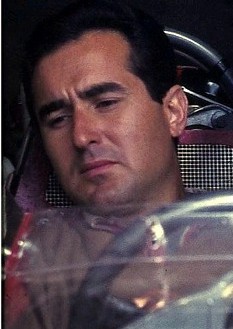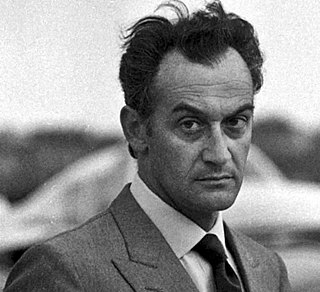
The 1958 Argentine Grand Prix was a Formula One motor race held on 19 January 1958 at Autodromo Municipal Ciudad de Buenos Aires Circuit. It was race 1 of 11 in the 1958 World Championship of Drivers and race 1 of 10 in the 1958 International Cup for Formula One Manufacturers. The race was the sixth Argentine Grand Prix. It was held on the #2 variation of the circuit. The race was held over 80 laps of the four kilometre circuit for a total race distance of 313 kilometres.

The 1958 Monaco Grand Prix was a Formula One motor race held on 18 May 1958 at Monaco. It was race 2 of 11 in the 1958 World Championship of Drivers and race 2 of 10 in the 1958 International Cup for Formula One Manufacturers. The race was the 16th Monaco Grand Prix and was held over 100 laps of the three kilometre circuit for a total race distance of 314 kilometres.

The 1958 Italian Grand Prix was a Formula One motor race held at Monza on 7 September 1958. It was race 10 of 11 in the 1958 World Championship of Drivers and race 9 of 10 in the 1958 International Cup for Formula One Manufacturers. Vanwall won the first Constructors' Championship in the category with 1 race left to go. After retiring his original car, entered by Scuderia Centro Sud, Carroll Shelby took over Masten Gregory's car, entered by Temple Buell, and finished fourth. No points were awarded for the shared drive.

The 1957 Formula One season was the 11th season of FIA Formula One motor racing. It featured the 8th World Championship of Drivers which was contested over eight races between 13 January and 8 September 1957. The season also included nine non-championship races for Formula One cars.

Karl Jockum Jonas "Joakim" Bonnier was a Swedish sportscar racing and Formula One driver who raced for various teams. He was the first Swede to both enter and win a Formula One Grand Prix.

The Coppa Acerbo was an automobile race held in Italy, named after Tito Acerbo, the brother of Giacomo Acerbo, a prominent fascist politician. Following Italy's defeat in World War II, and the consequent demise of fascism, the race was renamed the Circuito di Pescara, and in some years was also referred to as the Pescara Grand Prix and 12 Hours of Pescara. The race was run between 1924 and 1961 and over the years was held to a variety of vehicle class regulations and durations. In 1957 the Pescara Grand Prix formed a round of the Formula One World Championship, a race which still holds the record as having the longest circuit length ever used for a Championship event.

Lorenzo Bandini was an Italian motor racing driver who raced in Formula One for the Scuderia Centro Sud and Ferrari teams. He had one win in 42 Formula One races, and died from an accident at the 1967 Monaco Grand Prix when his open-wheel Ferrari 312 overturned and caught fire.

Masten Gregory was an American racing driver. He raced in Formula One between 1957 and 1965, participating in 43 World Championship races, and numerous non-Championship races. He was also a successful sports car racer, winning the 1965 24 Hours of Le Mans.
Behra-Porsche was a Formula One constructor which entered four World Championship Grands Prix across the 1959 and 1960 seasons. The constructor started - and finished - two races, both in the 1960 season, but scored no championship points in the process.

Giorgio Scarlatti was a racing driver from Italy. He participated in 15 Formula One World Championship Grands Prix, debuting on 13 May 1956.

Maria Teresa de Filippis was an Italian racing driver, and the first woman to race in Formula One. She participated in five World Championship Grands Prix, debuting on 18 May 1958, but scored no championship points. Though her Formula One racing career was brief, she won races in other series and is remembered as a pioneer in the sport.
Gilby Engineering was a British general engineering company and Formula One constructor owned by Syd Greene.
The 1957 World Sportscar Championship season was the fifth season of the FIA World Sportscar Championship. It was a series for sportscars that ran in many worldwide endurance events. It ran from 20 January 1957 to 3 November 1957, and comprised seven races.
Enrico Platé was a motor racing driver and team manager. Although born in Italy, Platé raced, and latterly ran his racing team Scuderia Enrico Platé, under Swiss nationality. He began his career as a mechanic, but swiftly took to racing cars in addition to repairing them. His best result as a driver was fourth place in the 1938 Modena Autodrome. Although he did not achieve any notable success in the pre-World War II voiturette class, Enrico Platé became a significant and influential figure in post-war grand prix and early Formula One racing as a team owner. During his brief career in this role, Platé ran Maseratis for notable drivers such as Prince Bira, Harry Schell and fellow Swiss Toulo de Graffenried.

Arzani-Volpini was an Italian Formula One constructor, established by Gian Paolo Volpini and engine-builder Egidio Arzani.

The Cooper T51 was a Formula One and Formula Two racing car designed by Owen Maddock and built by the Cooper Car Company for the 1959 Formula One season. The T51 earned a significant place in motor racing history when Jack Brabham drove the car to become the first driver to win the World Championship of Drivers with an engine mounted behind them, in 1959. The T51 was raced in several configurations by various entrants until 1963 and in all no less than 38 drivers were entered to drive T51s in Grand Prix races.

The 7th Modena Grand Prix was a non-championship motor race, run for cars complying with Formula One rules, held on 3 September 1961 at Modena Autodrome, Italy. The race was run over 100 laps of the circuit, and was dominated by British driver Stirling Moss in a Lotus 18/21.
Throughout its history, the Italian auto manufacturer Maserati has participated in various forms of motorsport including Formula One, sportscar racing and touring car racing, both as a works team and through private entrants. Maserati currently competes in Formula E in partnership with the Monaco Sports Group (MSG) as Maserati MSG Racing.

Alejandro de Tomaso was an Argentine racing driver and businessman. His name is sometimes seen in an Italianised form as Alessandro de Tomaso. He participated in two Formula One World Championship Grands Prix, debuting on 13 January 1957. He scored no championship points. He later founded the Italian sports car company De Tomaso Automobili in 1959.















